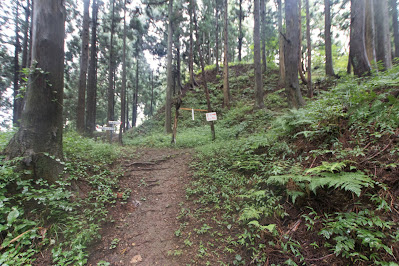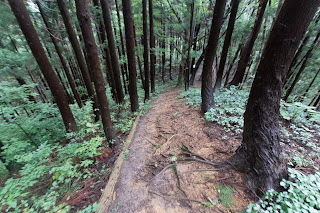Ikazuchi Castle
-Scribble described losers’ situation-
Overview
Name: Ikazuchi Castle (Ikazuchi-jo)
Alias:
Place: Sendai Gozen city, Niigata
Type: Mountain Castle
Built: 15th century?
Remaining remnants: Clay walls and dry moats
Title:
Brief History
Ikazuchi castle (雷城) is located over Ikazuchi-yama mountain, one of about 320 meter height from hillside at the center of current Gosen city. Ikazuchi-yama mountain is at the end of ridge spreads from Echigo mountain toward west between Hayade-gawa river and Senmi-gawa river, and faces flat area of Gosen city spreads at the south of Agano-gawa river.
From castle site mountain road goes up with Hayade-gawa and crosses Numagoe Toge pass then arrives at current Aga town. Now Aga town belongs to Niigata prefecture but prior to Meiji revolution it was a part of Aizu area of Mutsu province (east half of Tohoku region). Therefore, Ikazuchi castle was a border castle toward Aizu area.
Currently Route 49 directly connects Niigata city and Tsugawa town, the center of Aga town, but formerly the road avoided the narrow valley of Aga-gawa then Aizu Kaido road went up northward and crossed Suwa-Toge pass then headed Shibata city, and side road went down and arrived at Gozen area. These were communications and conflicts between Echigo province (Niigata prefecture) and Aizu area at these two roads.
Origin of Ikazuchi castle
It is not clear when Ikazuchi castle was built, but in the end of 15th century both of Nagao clan, the deputy governor of Echigo province, and Ashina clan which was the warlord of Aizu basin both established authority and started external conflict. Probably Nagao clan built Ikazuchi castle as the border castle toward Aizu province, and directly managed it.
In medieval era. there was Sugana manor at Sugana area, which was managed by Sugana clan. But different from other local lords around the province, Sugana clan might remain as small lord and did not show the presence among the province prior to 15th century. Sugana clan resided at flat residence near Ikazuchi castle.
In the middle of 16th century, Kenshin Uesugi (1530-1578), the governor of Echigo province, gathered local lords of the province and fiercely fought with other warlords such as Takeda clan or Hojo clan. Around this time Sugana clan gradually grew their power and was recorded on of the local lords subordinated to Kenshin Uesugi.
At this time Hideyori Murata (?-?), the retainer of Kenshin Uesugi, stayed at Ikazuchi castle as the commander. In 1564 Ashina clan intruded into Sugana area under the plot of Shingen Takeda (1521-1573), the warlord of Kai province (Yamanashi prefecture) and fatal rival of Kenshin Uesugi, and Ashina army once captured Ikazuchi castle.
Soon Uesugi army recovered Ikazuchi castle and placed Genzo Sugana (?-?), the leader of Sugana clan, as the commander of Ikazuchi castle. This might be done to integrate the troop of Sugana clan and Ikazuchi castle, to prepare for Ashina clan. After Genzo Sugana, his younger brother Tsunasuke Sugana (?-1582) succeeded the commander of Ikazuchi castle.
Structure of Ikazuchi castle
Rough shape of Ikazuchi castle is “L” latter shape, long line spreads northwestward and short line heads northeast ward. Central area of the castle is an L letter shaped one of about 50 meter long and 20 meter wide at the peak, which has a gate space at northwest ward. At the northeast of central area, secondary area that is same size exists at lower level, also has an entrance space at westward.
At the northwest of core areas, ahead of riding place and huge dry moat, third area and fourth area both are 50 meter long and 20 meter wide exist in line with the ridge. Edge of fourth area is protected by numerous small terraces, to prevent the movement of the enemy. Main climbing road from Yokokuji temple comes up to the edge of fourth area, and another road from residence of the road arrives at riding place.
At northeast of core areas, another line of several terraces spreads along the ridge, with dry moats protecting the edge. Total size of the castle is about 500 meter long and 300 meter wide, and core terraces of the castle are large and well shaped with defense facilities thus the castle might have been reformed by the end of Sengoku era.
Intrusion of Ashina clan into Echigo province
In 1578, Kenshin Uesugi suddenly died without deciding his successor from his two adopted son Kagekatsu Uesugi (1556-1623) and Kagetora Uesugi (1554-1579). Being affected by conflict between retainers of Uesugi clan, an internal conflict for successor named as “Otate-no-Ran” started just after the death of Kenshin Uesugi.
Ashina clan once failed to intrusion into Echigo province attempted the intrusion again just after the death of Kenshin but failed it and retreated. Later Ashina clan allied with Kagetora Uesugi under the request from Hojo clan which was the home of Kagetora Uesugi, and let their retainer Odagiri clan into Sugana area once more.
At the Yakushido hall of Byodoji temple built in the beginning of 16th century at the opposite of Numagoe Toge pass, there remains a scribble written by soldiers of Ashina clan participated in this battle. According to the scribble, as Kagekatsu confronted with Kanamari clan at Sanjo castle (Niigata prefecture), Ashina clan send their army under negotiation with Kanamari clan and its supporter Honjo clan at Tochio castle (Niigata prefecture).
Scribble described losers' situation
Ashina army intruded into Sugana area once captured major part of Sugana area, but being obstructed its movement by heavy rain the sent foot soldiers to Ikazuchi castle kept by Tsunasuke Sugana who belonged to Kagekatsu Uesugi. Ashina army approached to the edge of the castle and attacked the entrance then killed 30 enemies, but lost 50 soldiers and retreated.
Remaining Ashina army returned to their territory but being blamed by their lord Moriuji Ashina (1521-1580) then upper soldiers of Ashina army were imprisoned into the hall of Byodoji temple. The scribble was written by them this time, and it is quite valuable the detail of the lost of small battle is recorded precisely by letter, as lost battle is usually not recorded in paper citation and wooden hall is easily lost by fire or aging.
After nearly one year battle Kagekatsu Uesugi defeated Kagetora Uesugi and became the successor of Uesugi clan. At this battle Tsunasuke Sugana kept Ikazuchi castle and attacked enemy side castles such as Sanjo castle or Tochio castle then contributed to the victory of Kagekatsu Uesugi.
However, at current Shibata area at the north of Gosen area, Shigeie Shibata (1547-1587) who belonged to Kagekatsu Uesugi but was not rewarded rebelled against Kagekatsu Uesugi in 1581. At this time Ashina clan supported Shigeie Shibata, under acknowledgement of Date clan and central ruler Nobunaga Oda (1534-1582).
Afterward of castle
Shigeie Shibata well fought against Uesugi army and once broke it at the battle of Hosho-bashi bridge in 1583, close to kill Kagekatsu Uesugi. Kagekatsu lost generals at this battle, and Tsunasuke Sugana served vanguard due to closeness to Shibata area died in this battle.
After the death of Tsunasuke Sugana, Kagekatsu placed his retainer Suonokami Maruta (?-?), who might be a retainer of Sugana clan, as the commander of Ikazuchi castle. Maruta clan also activated at the battle against Shigeie Shibata, and kept Ikazuchi castle until the movement of Uesugi clan to Aizu area in 1598. In 1600, the ruin of Ikazuchi castle was used at the rebellion of local people against new lord Hori clan.
Now no building remains but structure of the castle well remain on the mountain. The climbing road is long and tough, and ahead of the climbing road unexpected huge castle with many soldiers exist. Soldiers of Ashina army might feel shocked arrival at the castle, and also despair on the returning way losing their colleagues and supporting injured fellows.
The regret of the Ashina army made the scribble in the hall is easily felt by visiting the castle and make a round trip to hilltop castle. After the death of Moriuji Ashina who continued military operations to surrounding warlords, Ashina clan was ruined in confusion only in eight year. Burden of too much operations ruined Ashina clan is simply but precisely expressed in this short scribble.
Access
30 minutes drive from Banetsu-do Expressway Yasuda interchange to parking space of Ikazuchi-yama mountain inside of Yokokuji temple. 60 minutes walk of sheer slope from parking to hilltop castle.
























































































































































































